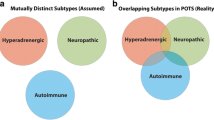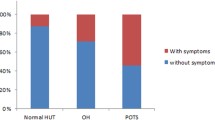Abstract
Patients with postural tachycardia syndrome (POTS) might be misdiagnosed with panic disorder due to shared clinical features. The first aim of our study was to investigate the relationship between symptoms of POTS and panic disorder. The second aim was to delineate clinical features distinguishing symptoms of POTS from panic disorder. A total of 11 patients with POTS and 11 control subjects participated in an IRB-approved, prospective, placebo-controlled study. The experimentally induced panic-like symptoms of POTS were systematically studied using the Acute Panic Inventory (API) questionnaire. The participants answered the questionnaire after each placebo infusion and after each of the three provoking stimuli: head-up tilt test (HUT), isoproterenol infusion (ISI), and sodium lactate infusion (SLI). API responses were summed for each subject at each time point of administration. Individual API symptoms and summed responses were analyzed for statistical significance. All patients with POTS developed symptoms of orthostatic intolerance during HUT. Pharmacologically induced symptoms subjectively mimicked spontaneous symptoms in 5 of 11 patients during ISI and in none of 11 patients during SLI. In contrast, API scores in these patients reached panic threshold in 0 of 11 following HUT, in 4 of 11 following ISI and in 4 of 11 following SLI. Individual symptoms analysis revealed that significant increase in scores was limited to the somatic symptoms of palpitations, dyspnea, and twitching or trembling. In conclusion, the symptoms of POTS are phenomenologically different and clinically distinguishable from panic disorder symptoms.

Similar content being viewed by others
References
Badoer E (2001) Hypothalamic paraventricular nucleus and cardiovascular regulation. Clin Exp Pharmacol Physiol 28:95–99
Balon R, Pohl R, Yeragani VK, Rainy JM, Weinberg P (1988) Lactate- and isoproterenol-induced panic attacks in panic disorder patients and controls. Psychiatry Res 23:153–160
Balon R, Yeragani VK, Pohl R, Muench J, Berchou R (1990) Somatic and psychological symptoms during isoproterenol-induced panic attacks. Psychiatry Res 32:103–112
Benarroch EE (2005) Paraventricular nucleus, stress response, and cardiovascular disease. Clin Auton Res 15:254–264
Benrud-Larson LM, Sandroni P, Haythornthwaite JA, et al. (2003) Correlates of functional disability in patients with postural tachycardia syndrome: preliminary cross-sectional findings. Health Psychol 22:643–648
Biaggioni I (1995) Orthostatic intolerance syndrome, vasoregulatory asthenia, and other hyperadrenergic state. In: Robertson D, Biaggioni (eds). Disorders of the autonomic nervous system. Harwood Academic Publishers, Luxembourg, pp 271–285
Clark RE, Squire LR (1998) Classical conditioning and brain systems: the role of awareness. Science 280:77–81
Da Costa JM (1871) An irritable heart: a clinical study of a form of functional cardiac disorder and its consequences. Am J Med Sci 61:17–52
Dillon DJ, Gorman JM, Liebowitz MR, et al. (1987) Measurement of lactate-induced panic and anxiety. Psychiatry Res 20:97–105
Fava GA, Mangelli L (1999) Subclinical symptoms of panic disorder: new insights into pathophysiology and treatment. Psychother Psychosom 68:281–289
Fraser F, Wilson RM (1918) The sympathetic nervous system and the “irritable heart of soldiers”. Brit Med J 2:27–29
Frolich ED, Dustan HP, Page IH (1966) Hyperdynamic beta-adrenergic circulatory state. Arch Intern Med 117:614–619
Gantt WH (1960) Cardiovascular component of the conditional reflex to pain, food and other stimuli. Physiol Rev 40:266–291
George DT, Nutt DJ, Walker WV, Porges SW, Adinott B, Linnoila M (1989) Lactate and hyperventilation substantially attenuate vagal tone in normal volunteers. Arch Gen Psychiatry 46:153–156
Goetz RR, Klein DF, Gorman JM (1996) Symptoms essential to the experience of sodium lactate-induced panic. Neuropsychopharmacology 14:355–366
Gorman JK, Kent JM, Sullivan GM, Caplan JD (2000) Neuroanatomical hypothesis of panic disorder, revised. Am J Psychiat 157:493–505
Gorman JM, Battista D, Goetz RR, Dillon DJ, Liebowitz MR, Fyer AJ, Kahn JP, sandberg D, Klein DF (1989) A comparison of sodium bicarbonate and sodium lactate in the induction of panic attacks. Arch Gen Psychiatry 46:145–150
Gramling SE, Clawson EP, McDonald MK (1996) Perceptual and cognitive abnormality model of hypochondriasis: amplification and physiological reactivity in women. Psychosomatic Medicine 58:423–431
Khurana RK (1995) Orthostatic intolerance and orthostatic tachycardia: a heterogeneous disorder. Clin Autonomic Res 5:12–18
Khurana RK, Chang PM (2001) Isoproterenol: clinical utility in patients with orthostatic intolerance and orthostatic tachycardia. Neurology 56:A425 (Abstract)
Khurana RK, Craig FW, Khurana S, Lynch JJ (2000) Orthostatic intolerance and orthostatic tachycardia: a psychological profile. Clin Autonom Res 10:253 (Abstract)
Khurana RK, Nicholas EM (1996) Head-up tilt table test: how far and how long? Clin Autonom Res 6:335–341
Leibowitz MR, Fyer AJ, Gorman JM, Dillon D, Appleby IL, Levy GL, Anderson S, Levitt M, Palij M, Davies SO, Klein DF (1984) Lactate provocation of panic attacks. Arch Gen Psychiatry 41:764–770
Liebowitz MR, Gorman JM, Fyer Aj, Levitt M, Dillon D, Levy G, Appleby IL, Anderson S, Palij M, Davies SO, Klein DF (1985) Lactate provocation of panic attacks. II. Biochemical and physiological findings. Arch Gen Psychiatry 42:709–719
Low PA, Schondorf R, Novak V, et al. (1997) Postural tachycardia syndrome. In: Low PA (ed). Clinical autonomic disorders: evaluation and management. Little Brown, Boston, pp 681–697
Pitts FN, McClure JN (1967) Lactate metabolism in anxiety neurosis. N Engl J Med 227:1329–1336
Pohl R, Yeragani VK, Balon R, Rainey JM, Lycaki H, Oritz A, Berchou R, Weinberg P (1988) Isoproterenol-induced panic attacks. Biol Psychiat 24:891–902
Schmidt NB, Lerew DR, Trakowski JH (1997) Body vigilance in panic disorder: Evaluating attention to bodily perturbations. J Consult Clin Psychol. 65:214–220
Shomali ME, Khurana RK (2005) Central adrenal insufficiency in patients with orthostatic intolerance and orthostatic tachycardia (OIOT). Clin Auton Res 15:347
Taylor S (ed.) (1999) Anxiety sensitivity: Theory, research and treatment of the fear of anxiety. London: Lawrence Erlbaum
Tukey JW (1949) Comparing individual means in the analysis of variance. Biometrics 5:99
Wager TD, LuanPham K, Liberzon I, Taylor SF (2003) Valence, gender, and lateralization of functional brain anatomy in emotion: a meta-analysis of findings from neuroimaging. Neuroimage 19:513–531
Wolpe J, Rowan VC (1988) Panic disorder: a product of classical conditioning. Behav Res Ther 26:441–450
Wood P (1941) Aetiology of DaCosta’s syndrome. Br Med J 1:845–851
Acknowledgments
This study was supported by Medstar Research Institute intramural grant 1999–376. The author thanks Norman Dubin, Ph.D., for detailed statistical analysis.
Author information
Authors and Affiliations
Corresponding author
Additional information
An erratum to this article is available at http://dx.doi.org/10.1007/s10286-007-0404-5.
Rights and permissions
About this article
Cite this article
Khurana, R.K. Experimental induction of panic-like symptoms in patients with postural tachycardia syndrome. Clin Auton Res 16, 371–377 (2006). https://doi.org/10.1007/s10286-006-0365-0
Received:
Accepted:
Published:
Issue Date:
DOI: https://doi.org/10.1007/s10286-006-0365-0




